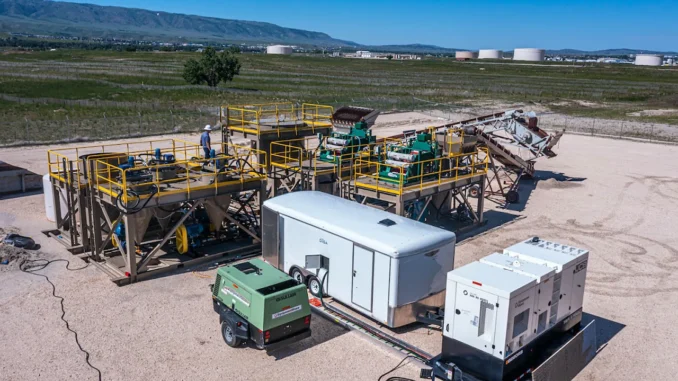
Casper-based Disa Technologies has a new patented mineral separation process that could have broad application in the mining and extraction sector, but is particularly exciting for rare earths and uranium remediation. It’s another cog in the wheel that’s been turning faster for rare earths and uranium in Wyoming.
The process is largely mechanical, taking advantage of varying degrees of hardness to achieve clean separations in slurry mixtures.
“Imagine like a tennis ball being covered in mud and you’re shooting these tennis balls at each other,” Disa CEO and co-founder Greyson Buckingham told Cowboy State Daily. “What happens when they hit? The mud breaks off, but the tennis balls stay intact. And that’s what we’re doing, effectively just shooting millions of particles at a time at each other.
Since Disa’s patented process generally involves a slurry that makes it a plug-and-play solution for most mining processes, which also involve slurries as part of their extraction process.
“It’s an easy, plug-and-play unit,” Buckingham said. “You don’t really need to make any changes. You would just plug our technology in there.”
Removing non-target materials from the extraction process early on can greatly improve the economics of extraction processes, and that’s where Disa’s process becomes a real winner.
“For example, we’re working on a phosphate project right now, and so the more gangue we can remove, the more that company saves because it’s not having to apply acid to that gangue,” Buckingham said. “So, if we can break most of that stuff off before it goes to the final step, that’s less acid being used.”
That not only makes processes more economic, it’s more sustainable overall, and there’s less acid to dispose of down the line, which is a triple win.
Backpacking Their Way To An Idea
The genesis of Disa, which registered with the Secretary of State’s office in 2010, was a backpacking trip in the Wind River Canyon.
“It was part of our MBA program,” Buckingham explained. “It was a requirement at the time to go on a backpacking trip through the Winds, which was fantastic.”
Co-founder and COO John Lee was one of Buckingham’s tentmates.
“During our reflection time, he and I really had a lot of conversations about what we wanted to do going forward,” Buckingham said. “And we were like, ‘Hey, we would really love to work together as entrepreneurs together.’”
It was Lee’s idea to enter the John P. Ellbogen $30K Entrepreneurship Competition. The duo placed second, bringing home $10,000 to kickstart their company.
The two also entered other kick-starter competitions to help them get capital, and they scrimped and saved any way they could.
“When we started working, I didn’t even take a salary the first few years with the company,” Buckingham said. “Luckily, I had finished almost a 10-year career in the Wyoming Army National Guard, so that kind of helped to pay the bills, and I’m also a licensed attorney.”
Buckingham has joint J.D. and energy management MBA degrees from University of Wyoming in 2018, when they registered Disa. Lee is finishing up a Ph.D. in mining engineering.
After validating their concept, Disa was able to attract investors to try the technology on a larger scale, and also test a number of different materials to figure out their best use-case scenarios.
“As a startup, we tried to avoid, you know, shiny-object syndrome, where it’s like, ‘Oh, let’s go this market, this market, this market,’” Buckingham said. “We needed to focus on top markets, you know, beachhead markets, and really prove out the technology in those specific cases.”
Once that’s been done, the company can branch out into other areas where the technology can be useful.

Uranium Game-Changer
Disa as a company is already global with a site in Australia and another in Canada, as well as sites across the United States, ranging from Nevada to Alabama, and points in between.
In addition to a recent, highly successful $15 million Series A funding round, Disa is already partnering with six companies on a Department of Energy grant involving its processes. Among this six is a company with a site in Wyoming, Ramaco Resources, which earlier this year announced it has a rich, unconventional deposit of rare earths that’s sandwiching its coal layers at a Sheridan coal mine.
Disa can’t yet say much about the partnership, but Ramaco Resources has previously told Cowboy State Daily that it is seeking alternatives for extracting its rare earths economically.
Disa is also working with the EPA on a study that will determine whether the process is a viable strategy for cleaning up legacy uranium mines.
The EPA is particularly interested in the process for abandoned sites near the Navajo Nation, where there are 523 abandoned uranium mines. Throughout the United States, the agency estimates there are 15,000 abandoned uranium mines.
“These were all mined during the Cold War,” Buckingham said. “And the low-grade uranium and everything else was just left on the surface. So, it’s just been sitting there from the 1950s to the 1980s.”
If proven out, Disa’s analyses suggest its process could be 50% to 80% more effective than existing treatments. That could have major implications for leftover uranium sites in Wyoming, the Four Corners states and other sites where low-grade uranium was mined.
“Uranium is a great example of how our technology works,” Buckingham added. “We’ve tested a dozen different sites, all legacy mine sites, and there’s a quantitative mineral, mostly found in the western U.S. that has a Mohs hardness scale of 2 to 3 and then the underlying sand grain, the quartz, has a Mohs hardness scale of 7.”
The Mohs scale measures a materials relative resistance to scratching. Lower numbers are softer materials, higher numbers are harder. It’s named after its creator, German geologist Friedrich Mohs.
With the waste material and the target material so far apart on the scale, that makes the two components easy to separate, and should allow all the radioactive elements to simply be removed from the abandoned sites.
“If we can remove the uranium, the radium and all those constituents of concern, the benign material can just remain on site,” Buckingham said. “And then that concentrate that has all those constituents of concern can either be recycled or deposed of at a low-level waste facility.”
ENB Top News
ENB
Energy Dashboard
ENB Podcast
ENB Substack



